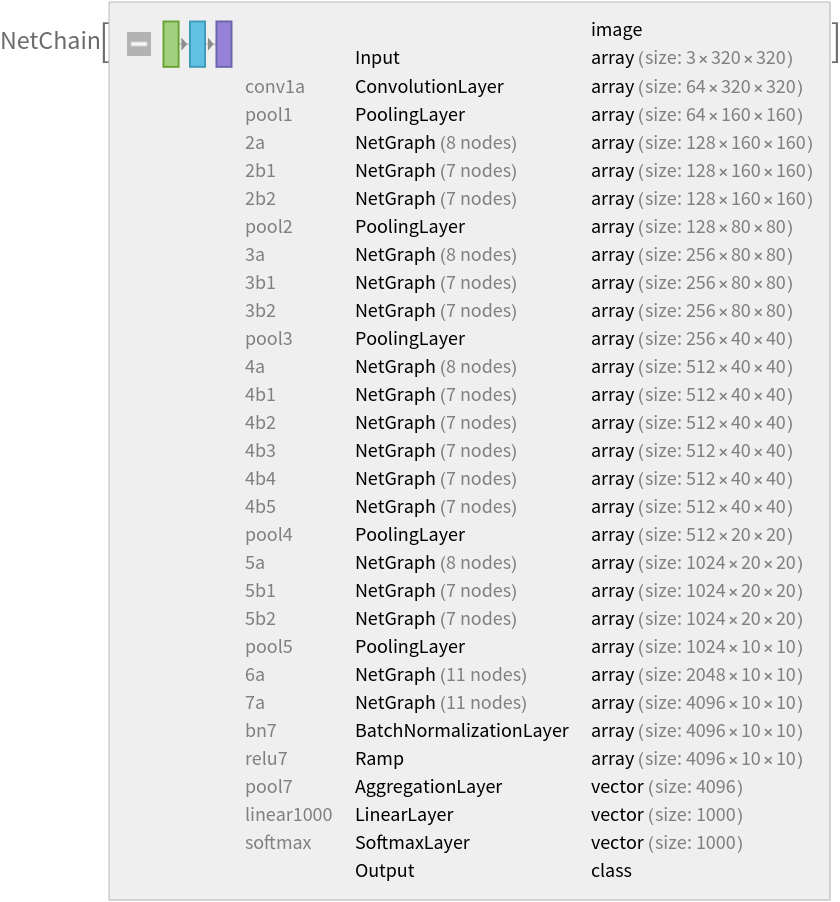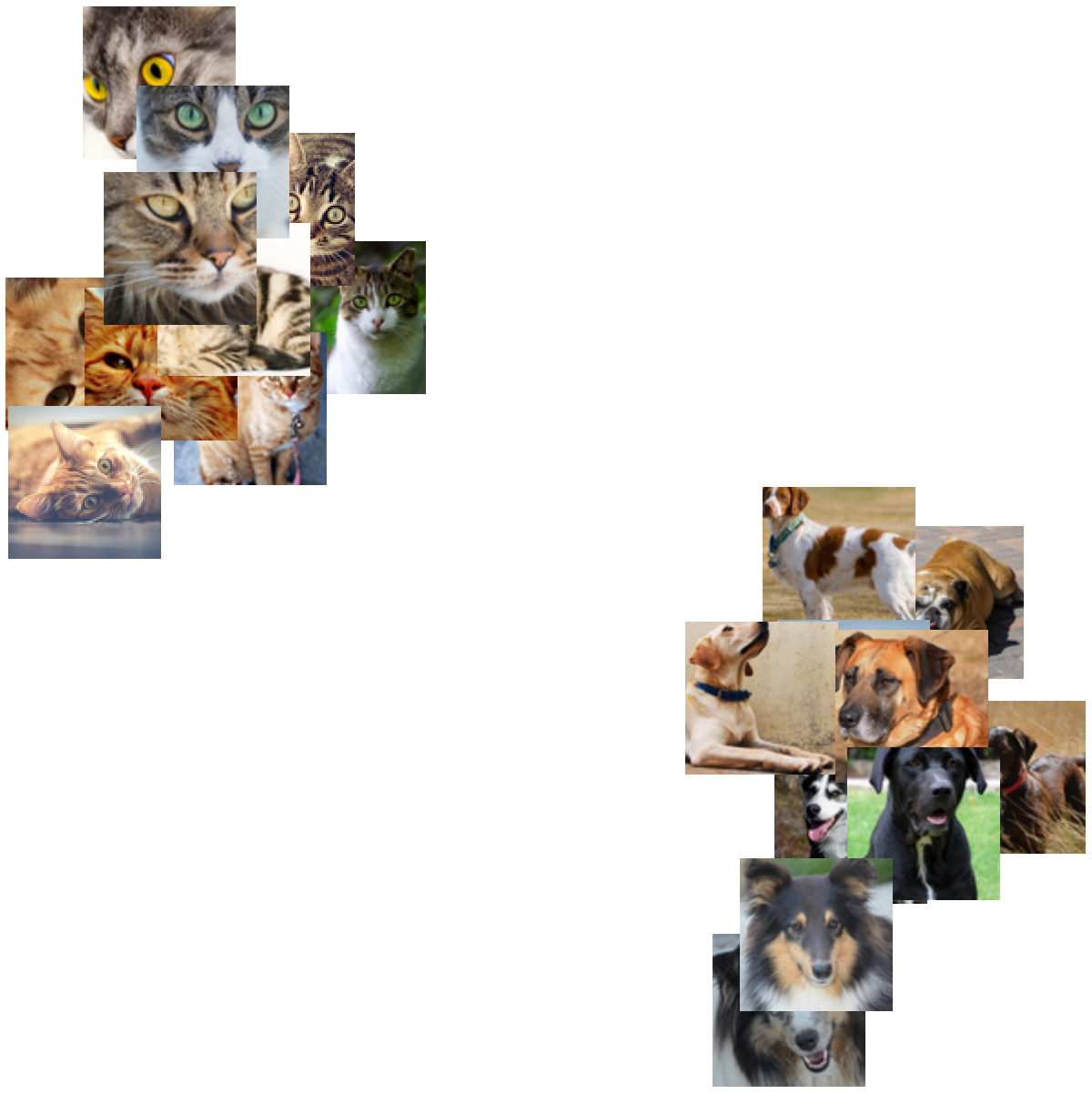Resource retrieval
Get the pre-trained net:
Basic usage
Classify an image:
The prediction is an Entity object, which can be queried:
Get a list of available properties of the predicted Entity:
Obtain the probabilities of the ten most likely entities predicted by the net:
An object outside the list of the ImageNet classes will be misidentified:
Obtain the list of names of all available classes:
Feature extraction
Remove the last two layers of the trained net so that the net produces a vector representation of an image:
Get a set of images:
Visualize the features of a set of images:
Visualize convolutional weights
Extract the weights of the first convolutional layer in the trained net:
Show the dimensions of the weights:
Visualize the weights as a list of 64 images of size 3x3:
Transfer learning
Use the pre-trained model to build a classifier for telling apart images of dogs and cats. Create a test set and a training set:
Remove the linear layer from the pre-trained net:
Create a new net composed of the pre-trained net followed by a linear layer and a softmax layer:
Train on the dataset, freezing all the weights except for those in the "linearNew" layer (use TargetDevice -> "GPU" for training on a GPU):
Perfect accuracy is obtained on the test set:
Net information
Inspect the number of parameters of all arrays in the net:
Obtain the total number of parameters:
Obtain the layer type counts:
Display the summary graphic:
Export to MXNet
Export the net into a format that can be opened in MXNet:
Export also creates a net.params file containing parameters:
Get the size of the parameter file:
The size is similar to the byte count of the resource object:

![(* Evaluate this cell to get the example input *) CloudGet["https://www.wolframcloud.com/obj/8a018e72-5e66-4107-aff8-66f288a2db0e"]](https://www.wolframcloud.com/obj/resourcesystem/images/52e/52e497ed-7c5f-4792-83ec-a025ee058c1a/10411c032d1e3528.png)

![(* Evaluate this cell to get the example input *) CloudGet["https://www.wolframcloud.com/obj/ca569394-6e46-48f0-9520-bd7c5b5b30da"]](https://www.wolframcloud.com/obj/resourcesystem/images/52e/52e497ed-7c5f-4792-83ec-a025ee058c1a/658637872b32d626.png)

![(* Evaluate this cell to get the example input *) CloudGet["https://www.wolframcloud.com/obj/c2d1f61f-839b-4dcb-a077-06fcdec2ce09"]](https://www.wolframcloud.com/obj/resourcesystem/images/52e/52e497ed-7c5f-4792-83ec-a025ee058c1a/7ddf86337a5b43b1.png)
![EntityValue[
NetExtract[
NetModel["Ademxapp Model A Trained on ImageNet Competition Data"], "Output"][["Labels"]], "Name"]](https://www.wolframcloud.com/obj/resourcesystem/images/52e/52e497ed-7c5f-4792-83ec-a025ee058c1a/79d0372df836d208.png)


![(* Evaluate this cell to get the example input *) CloudGet["https://www.wolframcloud.com/obj/aea1c796-a310-4cd0-bd20-400743ba6354"]](https://www.wolframcloud.com/obj/resourcesystem/images/52e/52e497ed-7c5f-4792-83ec-a025ee058c1a/355594411167fa40.png)


![(* Evaluate this cell to get the example input *) CloudGet["https://www.wolframcloud.com/obj/e90d7ed5-673a-4964-a4f1-5d98081615b4"]](https://www.wolframcloud.com/obj/resourcesystem/images/52e/52e497ed-7c5f-4792-83ec-a025ee058c1a/30391e6cca202327.png)
![(* Evaluate this cell to get the example input *) CloudGet["https://www.wolframcloud.com/obj/d952f7c4-e1d4-4a9e-83d4-b83172dbfbb2"]](https://www.wolframcloud.com/obj/resourcesystem/images/52e/52e497ed-7c5f-4792-83ec-a025ee058c1a/1e599d4902eba3ec.png)

![newNet = NetChain[<|"pretrainedNet" -> tempNet, "linearNew" -> LinearLayer[], "softmax" -> SoftmaxLayer[]|>, "Output" -> NetDecoder[{"Class", {"cat", "dog"}}]]](https://www.wolframcloud.com/obj/resourcesystem/images/52e/52e497ed-7c5f-4792-83ec-a025ee058c1a/5abb20554ea9869e.png)


